Get ready for the main course! RIO’s cash splash was just a taster
Credit Suisse is bullish on equities over the medium term, despite the "froth" that is clearly disseminating across the market and investor's all-enveloping fear of inflation.
In fact, the firm's private bank chief investment officer Andrew McAuley believes that these "optically stretched" valuations are concealing the upgrades in corporate earnings to come, while Credit Suisse's fixed income portfolio manager Jasmin Argyrou's contrarian view on cash rates could also see equities soar even higher.
As reporting season kicks off, Credit Suisse argues that dividends are back - and with a vengeance. The firm's equities portfolio manager Mike Jenneke is backing Aussie miners, the likes of BHP, Rio Tinto and Fortescue Metals Group, and predicts investors are likely to see further earnings upgrades on the horizon.
Further for those with a penchant for dividends, Jenneke believes we are likely to see double-digit earnings growth across most of the ASX's sectors over the coming months. And he argues the recent NAB and ANZ buybacks are just a "taste of what's to come".
In this wire, I summarise some of the key points from Credit Suisse's latest media briefing, including why cash rates are likely to stay near zero well beyond the Reserve Bank of Australia's scheduled hike in 2024 and why any market correction in the coming months should be seen as a buying opportunity.
What to expect for the coming six months
McAuley believes that we are likely to see a "mini correction" over the next month or two, and notes the firm currently has a 5% exposure to cash so that it is on the front foot of any opportunities that emerge.
"We're thinking there'll be some sort of dip in equity markets in the next month or two, as valuations get full and as risks - like the Delta variant and Chinese regulation - flow through," he said.
"At the moment we're not seeing that weakness. Pretty well every month it's positive returns. But beyond the next two months, we think that the vaccine rollout is happening in developed markets and it's inevitable that the situation will improve and the opening up post-COVID will continue, and that there will be monetary and fiscal policy support as needed."
What's more, governments and central banks have shown that they are willing to do more and remain dovish for longer if needed, McAuley added.
The bond market implications - and why cash will stay lower for longer
Argyrou believes we are likely to see another dip in Australia's GDP output in the September quarter as a result of the lockdowns we are seeing in NSW at the moment. She argues that this dip will be followed by a V-shaped recovery, similar to what we saw in 2020.
The below chart highlights Australia's GDP output over time. The blue vertical line constitutes Credit Suisse's forecasts for GDP in the future.
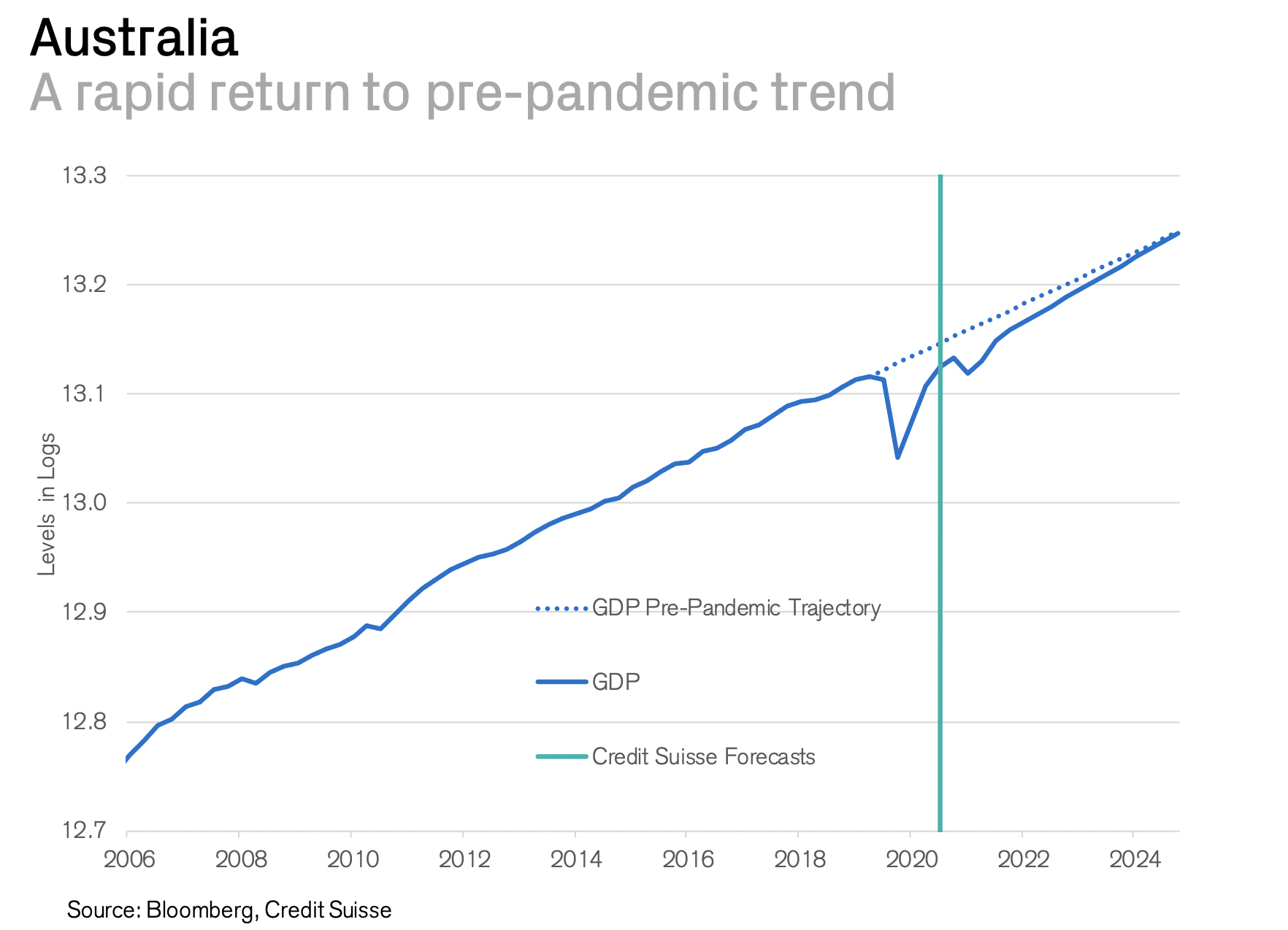
The dotted line in the above chart shows where Aussie GDP would have been had the pandemic never occurred, assuming that GDP would have continued on its trajectory of pre-COVID-19 growth.
"Over the long term, our economy, based on our projections, is expected to return to that pre-pandemic trend in 2025," Argyrou said.
"The key question is, 'Will this be enough for the Reserve Bank of Australia. Does this return to the pre-pandemic trend mean the economy has reached its speed limits?' That is, the pace that it cannot exceed without generating too much inflation."
To answer this question, Argyrou refers to the below charts, which track the growth rate of hours worked in aggregate as well as how intensively we worked (productivity rate).
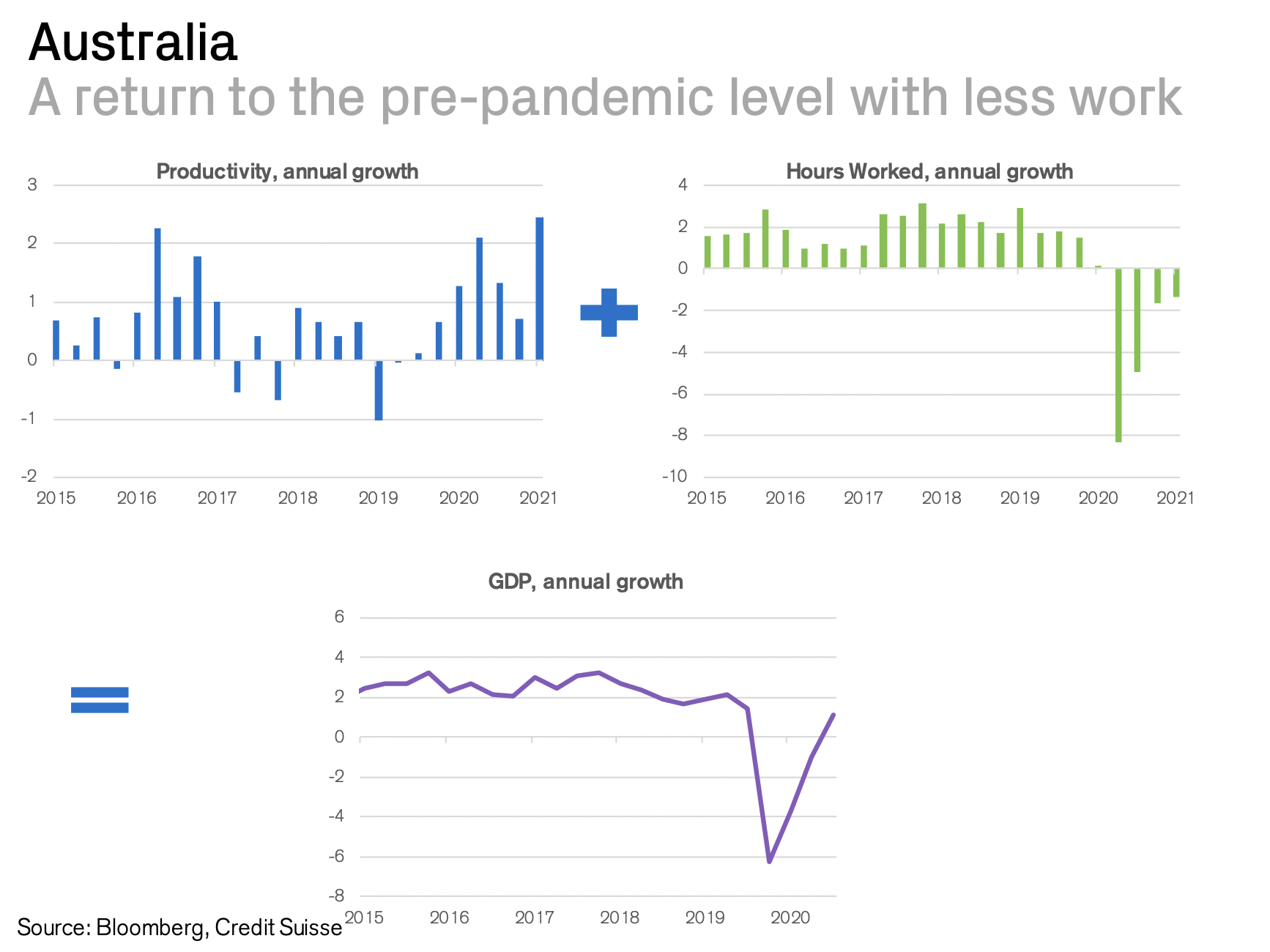
"If we can find ways to utilise technology to produce more in every hour we work. And we do that on an ongoing basis - if we can sustain that - it has a very big implication for the speed limit of the economy," she said.
"What it means is that we can grow faster than we did in the past, without overheating."
Interpreting productivity growth over short time periods can be difficult, as data is impacted by noise (particularly during economic slumps), Argyrou said.
"Nevertheless, we know the underlying trends that the pandemic has accelerated; e-commerce, automation, digitalization," she said.
"It's reasonable to expect that these trends will make our economy more productive. What is the point of them if they don't?"
Over the past year, Australia's GDP has returned to pre-COVID levels, but we have done this by working fewer hours than we did before the pandemic, Argyrou explained, relying on productivity growth instead.
"Perhaps, necessity is indeed the mother of all invention, as they say, or to quote, Winston Churchill, never let a good crisis go to waste," she said.
If we can continue to achieve faster productivity growth than what we have generated over the past five to 10 years, it is likely that this will be positive for earnings as well as household income, Argyrou said. However, at least over the short term, this would be negative for inflation.
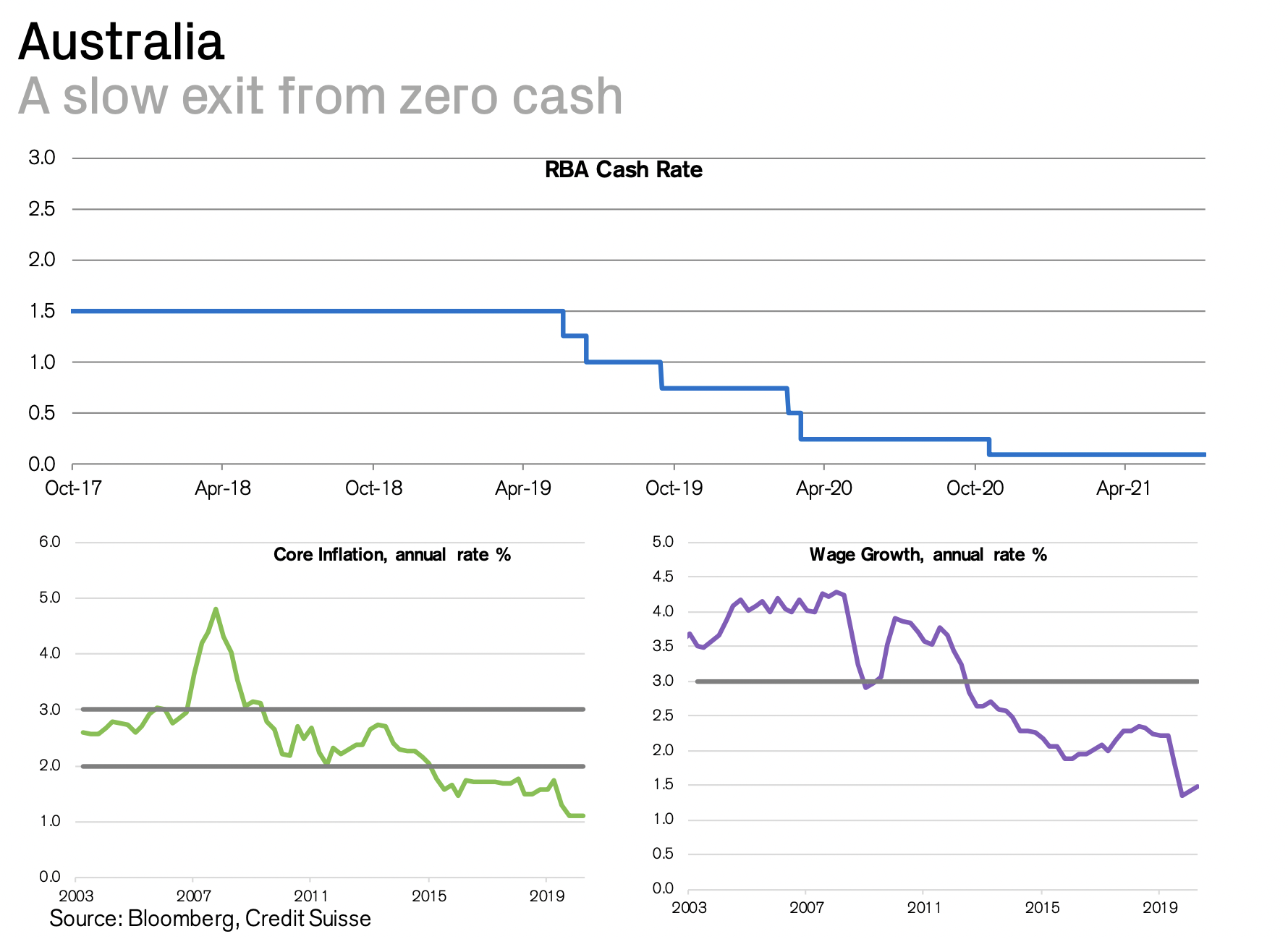
Argyrou believes that in order to stem disinflation in this higher productivity growth environment, we will need wage growth to be closer to 4% (RBA target at 3%).
"Over the past five years, productivity growth averaged 0.5% and wage growth was on average above 2%. That combination was not enough to stop inflation from falling," she said, as seen in the bottom left and right chart above.
"If we can hold on to some of the productivity gains that we have already generated. And if we can keep it going for a little bit longer, then higher wage growth will ... certainly be higher than the wage growth that we're generating now, but it will also be higher than the 3% implicit target that the RBA has," Argyrou adds.
For this reason, she believes that the cash rate is likely to stay unchanged close to zero for a lot longer than the market is expecting - as well as the RBA's own 2024 guidance.
She also argues that the housing market is more likely to overheat than the labour market, and as such, believes it is likely that macro-prudential tightening will be introduced before the cash rate increases.
And while inflationary pressures are likely to persist in the US, Argyrou argues these will likely support corporate earnings and thus equity markets.
What this means for equities
Jenneke noted that we saw a 24% decline in earnings during FY20; a similar decline to what was experienced during the Global Financial Crisis.
"The difference between this cycle and the recovery from the GFC is that this is one of the strongest profit rebounds that we've seen in the history of the ASX," he said.
"It's unprecedented in terms of its size over a one year period, and to put it in context, the aggregate earnings growth that is expected in FY21 is likely to be somewhere around 45%."
For FY22, most sectors are expected to deliver double-digit growth, Jenneke said. While the earnings recovery is being led by the big sectors; mining and resources, and banks.
"There were big declines in energy but iron ore rebounded pretty quickly, so it was only a 5% decline last year. And from that base, earnings are expected to be up 80% this FY21," he said.
"Banks are expected to post 50% earnings growth in FY21. So these two sectors in particular account for 60% of ASX profits. Also a pretty similar proportion of dividends right now, but more weighted towards miners rather than banks."
ANZ and NAB's $1.5 billion and $2.5 billion buybacks are also "just a taste or instalment of the buybacks to come," Jenneke adds.
"There is sufficient confidence in the economy and in the measures that we have, that banks are starting to return capital regardless of the lockdowns. But it's also a reflection of the size of the capital buffers that they have in place as well," he said.
"That's why I say it's just an early instalment."
For context, Jenneke notes that post these recently announced buybacks, the Big Four banks should be able to return at least $30 billion in capital to shareholders.
"CBA is looking to return somewhere around $12 billion or so. Westpac at least $8 billion and that will probably get higher once they sell more of their assets," he explained.
"The return of capital is just going to continue to expand on top of the restoration of sustainable dividend payout ratios in the 65-70% range, which they should be reporting from here on in."
In addition, Westpac and CBA both have substantial excess franking credit balances, Jenneke said.
"Westpac has got close to $4 billion of franking credits. These two banks have the opportunity to return capital in a more tax-efficient manner through an off-market buyback, which is good for shareholders in terms of the buyback price but also returning those franking credits," he said.
"So this is just a taste of what's to come."
This strong earnings recovery in the banks and miners is likely to translate to further upside in Aussie equities next year, Jenneke adds.
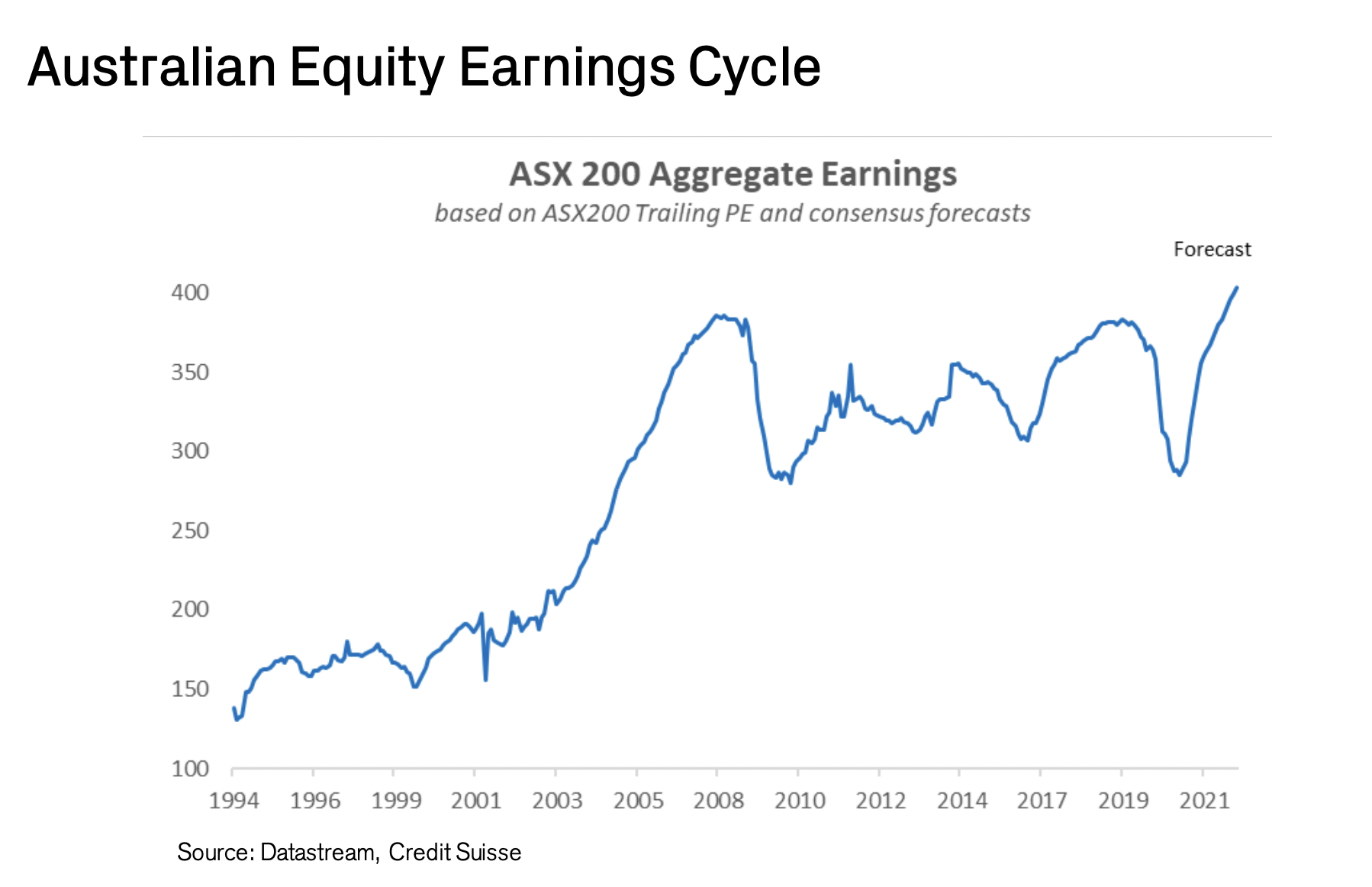
And why Credit Suisse is backing Aussie miners
The mining sector is one of Credit Suisse's largest overweights within its Australian equities portfolio, Jenneke explained, pointing to positive shifts in commodity markets that have not yet been translated in valuations for his thesis.
"The main shift that's occurred is that markets are structurally tight on the supply side ... yet demand is continuing to grow," he said.
"Particularly with the stimulus measures that we've seen through the pandemic, in China but also around the world, commodity demand is very healthy. And we're not expecting to see much supply response going forward."
Despite prices being higher than what investors would expect over the long term - Jenneke believes that they will continue to stay at historically elevated levels for an extended period of time (although he adds we may see some correction in prices before they return to highs).
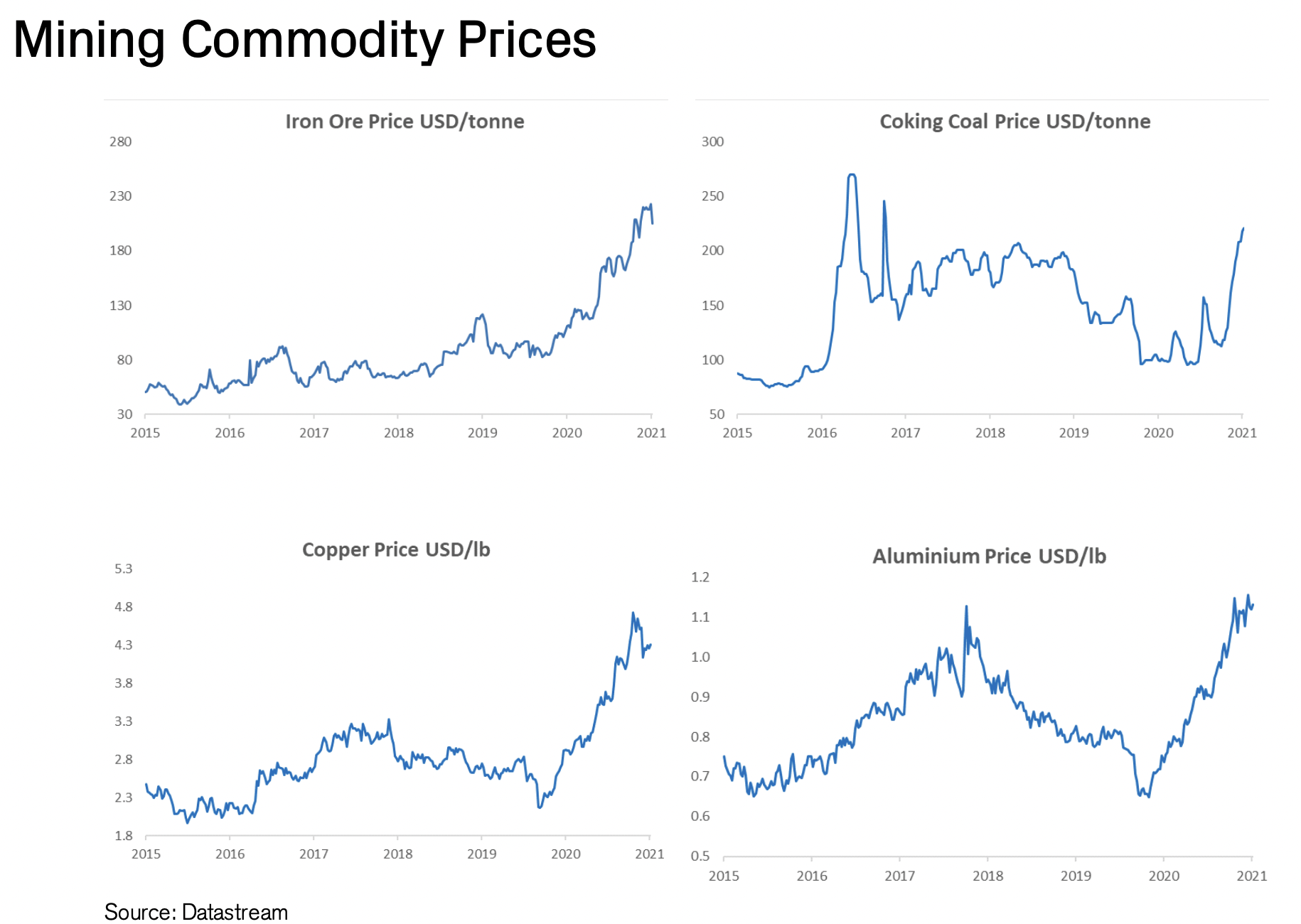
"The other shift that we're seeing is from the companies themselves; the major miners are at their most cash generative that they've ever been in their history," he said.
"So, capital expenditure and volume expansion is very much incremental and modest compared to what we've seen in the past when there have been very substantial prices."
Jenneke believes that it is unlikely that this will change going forward, and points to constraints from management "given the impact of the last boom on returns" as well as ESG factors "constraining the ability to find low-cost supply alternatives" for his positioning.
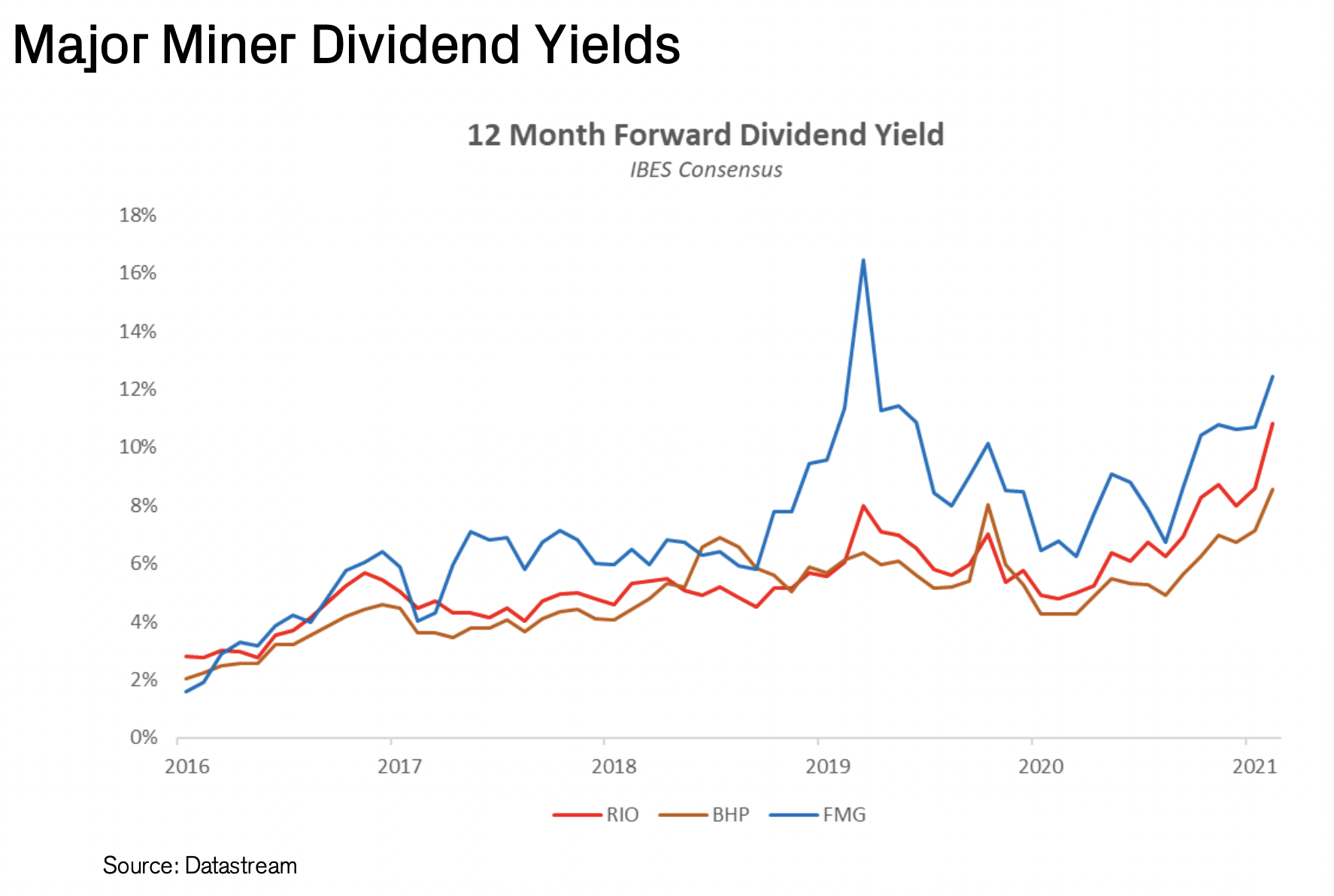
Furthermore, consensus forecasts show that dividend payments coming from Rio Tinto (ASX: RIO), BHP Group (ASX: BHP) and Fortescue Metals Group (ASX: FMG) will hit double-digit yields in the short term, Jenneke said.
"In the near term, you're picking up huge dividend yields, and we think that investors are just too conservative in projecting commodity prices falling back to long term trends," he said.
He points to Rio Tinto's recent result as an example of what is to come, with the company reporting $3 billion of cash on its balance sheet, despite a $9 billion dividend payout set for September.
"This is the highest dividend that the company's ever paid for an interim and actually exceeded its total annual dividend in history," Jenneke said.
"That's just a taste of what's to come because Rio would actually typically bias its dividend towards the calendar year. It will pay a much higher dividend in the second half than it's just paid in the first half, particularly if the outlook continues to be as constructive as it is."
As seen in the chart above, Fortescue was slightly earlier on the high yield trend. However, Jenneke expects Rio and BHP will similarly shift as they start generating more cash and "pay these enormous dividends".
"We acknowledge that commodity prices will be volatile, they are likely to come down at some stage. Regardless of that, the profile of the cash generation of these companies is quite exceptional, and is likely to be attractive going forward," he said.
"For us, this is an important underpinning of the Australian equity market. It's the largest generator of profits, and the largest generator of dividends for ASX shareholders, certainly over the next 12 to 18 months. So we see that as an important underwriter of the market generally."
Never miss an insight
Enjoy this wire? Hit the ‘like’ button to let us know. Stay up to date with my content by hitting the ‘follow’ button below and you’ll be notified every time I post a wire. Not already a Livewire member? Sign up today to get free access to investment ideas and strategies from Australia’s leading investors.
3 topics
8 stocks mentioned
2 contributors mentioned

